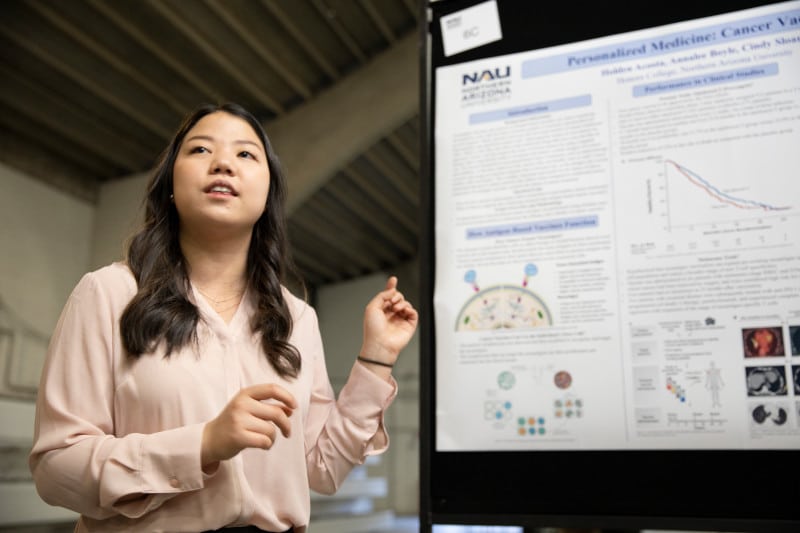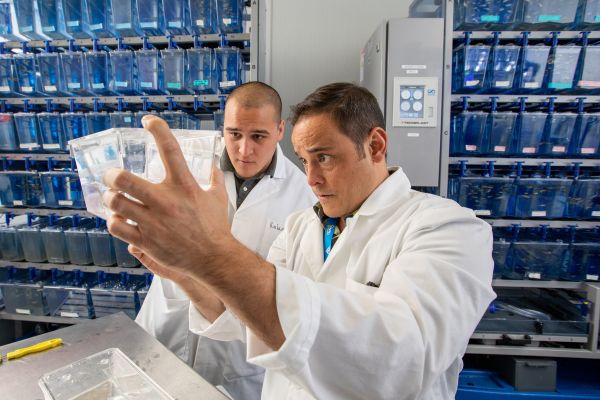At Northern Arizona University, research is open to every undergraduate in every discipline, and at the 2020 Virtual Symposium, the NAU and Flagstaff communities are invited to see the results of student research projects from every college.
Although the gathering is typically held at the NAU Fieldhouse, this year’s symposium, which runs from April 20-24, is being hosted online in light of COVID-19 restrictions. The weeklong event is a showcase of more than 1,000 undergraduate researchers in the arts, business, education and the humanities. This year, graduate students are joining the symposium as well.
Students are sharing their creative discoveries online, presenting in-depth research and scholarly work. Visit the Virtual Symposium to meet students who are changing the world one discovery at a time, including:
- Biomedical science major Phillip Kalaniopio, who is testing drugs for treating melanoma, the deadliest form of skin cancer
- Political science major Ayanna Desquitado, who is using urban history to study social justice
- Math major Reilley Luedde, who uses data analysis and business acumen to profit in the currency market
- Geology major Cecily Combs, who studies hydrogeology to improve forest health and increase biodiversity
Visit the Virtual Symposium and view the student presentations in this online gallery.
Phillip Kalaniopio: Making an impact searching for cancer-fighting drugs
When it comes to cancer research, senior Phillip Kalaniopio is a self-proclaimed “nosy person.” He is putting that inquisitive nature to work on a project looking for effective drug combinations to treat the deadliest form of skin cancer—melanoma.
“I’ve had a lot of family members that have had or still have cancer. It’s one of those diseases that infuriates me, because there is no answer to it, right?” he said. “I just want to know the answer. This is my opportunity to figure it out, essentially.”
Kalaniopio is part of a project headed by assistant professor Matthew Salanga and professor Richard Posner. Salanga and Posner received a $100,000 grant from the Flinn Foundation to test novel drug combinations in the treatment of melanoma, in partnership with scientists at the Translational Genomics Research Institute (TGen) and Los Alamos National Laboratory.
Kalaniopio is involved in multiple stages of the study, which uses zebrafish as test subjects because of their genetic similarity to humans, with 80 percent of genes linked to human disease also being expressed in these fish. The zebrafish in Salanga’s lab are humanized, which means they carry a gene from humans associated with cancer—BRAFV600E. The humanized zebrafish are albino, without their namesake zebra stripes, which protects them from melanoma. At the embryonic stage, Kalaniopio and others in the lab give them back their stripes by injecting them with a plasmid—used to add transgenes to the fish’s genome—called MiniCoopR.
“By adding the transgene and having the BRAF mutation in their background, the fish recovers its stripes and its susceptibility to melanoma, which, in our experience, presents at around four to six months of age,” he said.
Posner and his group, including Kalaniopio, conduct computational modeling to determine the right combination of kinase inhibitor drugs to test on the fish with melanoma. After the fish are treated with the drugs, Kalaniopio and others euthanize the fish and measure the amount of cancer-causing protein in order to see if the drug combinations achieved the desired outcome.
“I probe to find out whether the cellular signal has lessened,” Kalaniopio said. “And if that’s there and at lower levels than, say, a fish that didn’t get this treatment, then we can pretty conclusively say that, yes, this treatment, to some degree, worked.”
Kalaniopio will be graduating this May with a bachelor’s degree in biomedical science. After that, he will be working toward a Ph.D. in biology as he continues his efforts in Salanga’s lab. He wants to continue to conduct cancer research. He initially planned to go into medicine, but his undergraduate research experience changed his goals.
“I realized how much of a difference I can make by doing this type of research,” he said. “I feel like I can really make an impact.”
Kalaniopio’s mentors, Salanga, Posner and biological sciences professor Catherine Propper, have helped him grow as a researcher.
“They’re never that easy on me because research isn’t easy,” he said. “They let me figure it out on my own, and they’ll help me if I really need help. But they’ve been really good mentors for me to learn how to be a scientist.”
Kalaniopio is proud to be a first-generation student and Native Hawaiian. He also is proud of his research and the Hooper Undergraduate Research Award (HURA) he received for his work on Salanga’s uranium toxicity project. He credited NAU staff and programs for helping him as he worked through his undergraduate degree, especially Tina Zecher, assistant director, Office of Undergraduate Research and Creative Activity, and Jen Johnson, senior program coordinator, Louis Stokes Alliance for Minority Participation (LSAMP). LSAMP funded two conference trips and helped fund his work with research projects.
“Those programs really have helped me a lot,” he said. “They helped me forge my path through school. I’ve decided I want to do this whole research thing as my career.”
Ayanna Desquitado: Shining a light on notorious public housing project, social justice
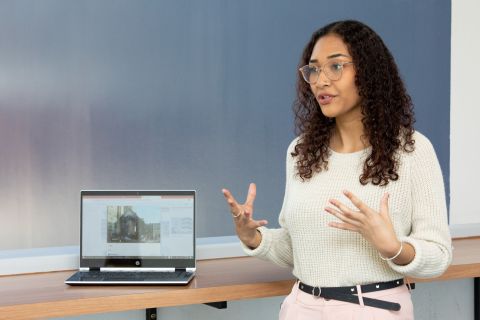
What happened next is the subject of sophomore Ayanna Desquitado’s research. In a textbook case of gentrification, the poorer and predominately African-American residents were displaced by more affluent, mostly white residents as housing costs in the area soared. Desquitado’s research was inspired by her mentor, Jessi Quizar, NAU assistant professor of ethnic studies, whose work finds parallels between colonization and gentrification.
A political science major with a minor in civic engagement, Desquitado, who is passionate about social justice, was immediately interested in the project. Her research has involved reading about the history of the area—the bureaucratic and the human—and examining old photos.
“I read personal stories of people who lived in those public housing units,” she said. “And then I looked at the more historical side. And I studied the politics of why they decided to demolish Cabrini-Green, why gentrification took place afterward and what that looks like, physically, in the neighborhood.”
With an Interns to Scholars program grant and a Jean Shuler Research Mini-Grant, Desquitado will travel to Chicago to compare the reality of today’s Cabrini-Green area with historical photographs she has collected. She is especially interested in the community spaces that have been lost.
“My main goal is to show how dangerous gentrification can be and give people that visual aspect of it, while also showing the culture of those people who have now been displaced because of gentrification,” she said. “The pictures that I’m specifically looking at and trying to compare are cultural sites, mainly; I’m looking at elementary schools and parks and things like that.”
She also is examining the number of minorities, specifically African-Americans, who lived in the area before gentrification and comparing that to the number who live there today.
“Typically, white upper-class or middle-class people moved into these areas and then poor black families had to move out because they can no longer afford the rent,” she said.
Desquitado said she is grateful for the opportunity to conduct research as an undergraduate and the experience has her reassessing her professional aspirations.
“I have really enjoyed doing this research, and it’s given me an advantage because a huge part of political science is conducting this type of research,” she said. “It has led me into considering new career paths. As a poli sci major, I’ve always kind of just thought about being in government and just in politics in general, but now I’m thinking about maybe pursuing a career in academia.”
Reilley Luedde: Can big data can make big money through math, data analysis and business acumen?
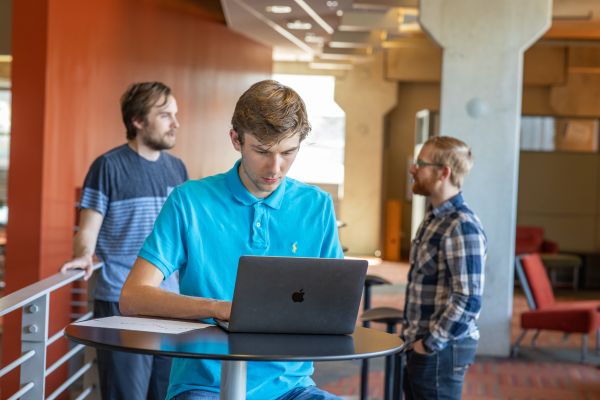
The currency market functions much like the stock market in that traders buy and sell currencies from throughout the world, trying to take advantage of shifting exchange rates to make a profit.
Luedde, who is majoring in mathematics and minoring in computer science, actuarial science and business, initiated the project to follow his own academic interests. He presented his idea to a coding club, where he found research partners Anthony Simard and Chris Keefe. The trio then went to The W. A. Franke College of Business to find a professor willing to mentor them. There they teamed up with assistant professor of practice Paul Wagner.
Their project includes gathering historical information about market activity and looking for patterns.
“We’re essentially building models that tell us when to buy and sell a certain asset,” Luedde said. “Right now, we have what are called indicators—basically recalculations of the price of the assets. So, a moving average, for example, is one indicator. And that averages prices over a certain period, for example, over the last 20 days. And then when another day comes around, it takes the last 20 days, starting from the new day. It’s like a constant window that is moving as the price changes.”
Luedde has been working to translate these indicators into the Python programming language in preparation for data analysis.
“I’ve also been doing a little bit of research to learn what is a profitable system, what isn’t a profitable system and what might be a red herring—something that seems very good on the outside, but actually isn’t.”
The work Luedde and the team are doing represents a financial trading discipline called technical analysis, which is essentially using patterns in price and indicators to predict future price.
“If you can predict future price with some sort of reliability, then that means you can extract some sort of profit,” Luedde explained.
It’s a field he wants to explore in graduate school.
“I want to get into a quantitative engineering or quantitative finance master’s program, so I figured I should get some research experience before applying to grad school,” he said.
It’s too soon to say if the research partners have successfully mixed the secret data sauce for profit, but the experience alone has been worth the hard work, Luedde said.
“I’ve learned about how research is done,” he said. “I’m expanding my skill set and I’m learning new things.”
He aspires to be a quantitative trader on Wall Street, “which is somebody who does pretty much exactly what we’re doing, except with a lot more math.”
Leading into the symposium, Leudde and his partners are discussing the ethics and legalities involved, should they find a successful formula, such as whether they should share the details or keep the information private.
“That’s something we’ve been thinking about. And that’s a bridge we’re going to cross if it happens.”
Cecily Combs: Finding her research home in geology, 4FRI project
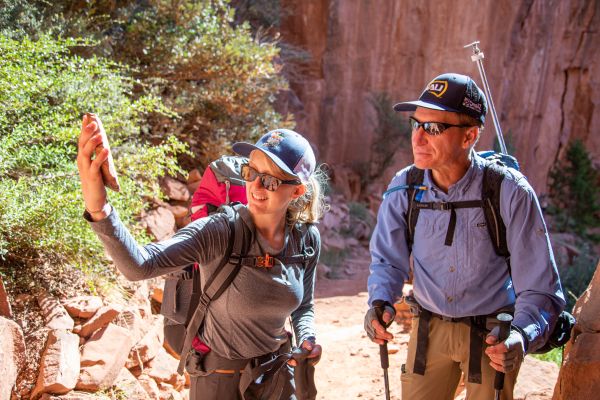
The Four Forest Restoration Initiative (4FRI) project is a collaboration between multiple stakeholders, including NAU and the U.S. Forest Service, to restore southwestern forests to their pre-colonial conditions. The intent is to increase biodiversity and make forests more resilient.
As a student researcher for hydrogeology and ecohydrology professor Abe Springer, Combs is responsible for monitoring and obtaining water samples from four springs—one in the Kaibab National Forest, one on Hart Prairie, one near Lake Mary and the other near Long Valley. Combs samples the springs before and after the monsoon and before and after snowmelt to see how much water is flowing out of the springs. By recording and maintaining the data, Combs’ research provides a longitudinal view of the effects of the 4FRI forest thinning efforts and controlled burns on groundwater recharge.
The hypothesis, Combs explains, is that with fewer trees to hold moisture, less moisture will be lost to evaporation and plant transpiration. More snowmelt and rainfall, in turn, will infiltrate the ground and recharge the aquifer.
“Some of the sites have received forest thinning treatments,” Combs said. “We’re hoping the data we collect this year will start to show us trends.”
Combs is happy to play a small part in such an ambitious undertaking. The 4FRI project is now a decade into its 20-year lifespan, and many students at NAU have taken part.
“It’s honestly pretty amazing to know that as an undergraduate with no real qualifications, I was allowed to participate in something that’s going to be a long-standing project, something that’s going to make a difference,” she said. “And I know that I’m just one of many students who is going to be in this spot doing the same research, so I’m going to have to hand over whatever results I get to the next person in just a few months. I need to have all my ducks in a row. My data needs to make sense. I need to have results that they can take and go further with.”
Not too long ago, Combs would have never guessed she would be working on 4FRI or in hydrogeology research at all. During her senior year of high school in Gilbert, she wanted to go to a liberal arts school out of state.
She visited NAU and realized she liked Flagstaff, as well as the scholarships NAU was offering.
Once at NAU, Combs still didn’t have a clear academic plan. She tried several liberal arts majors.
In her sophomore year, she enrolled in Geology 112: Geologic Disasters, a class that non-majors take to get their required lab and science credits.
“It actually ended up clicking with me,” Combs said. “I really enjoyed that class, and after a little while I realized that if I thought it was super cool, maybe I should look into geology.”
A semester later, she declared her major. When she eventually met Springer and expressed an interest in research, he invited her to his weekly research group meetings.
Even though she hadn’t yet taken a hydrogeology class, Combs felt at home with her newfound peers. Eventually, the 4FRI opportunity with Springer opened up.
Combs appreciates the guidance she has received from Springer.
“I like that he doesn’t let you get lost,” Combs said. “He encourages us to work with each other, play to our strengths and build our network connections. He’s really encouraging us not to grow just as scientists, but as people too.”
The collaboration and support she has received at NAU from Springer and others have made an impact. Her aspirations are much clearer now—Combs sees research in her future, whether in graduate school or for a public or private employer.
“I enjoy learning new systems,” she said. “I feel like it’s more of a team effort, because I don’t know how to do most of this stuff on my own. Having this opportunity and learning how to talk to other people has been good.”
